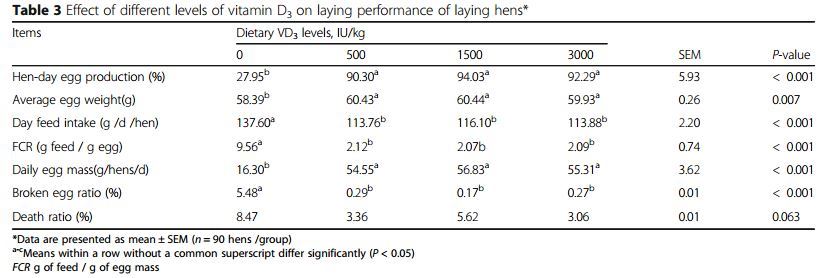Hens with Vitamin D were better in at least 5 ways – RCT
Dietary vitamin D3 supplementation protects laying hens against lipopolysaccharide-induced immunological stress
Yanqiang Geng, Qiugang Ma, Zhong Wang wangzh@cau.edu.cn, and Yuming Guo
Nutrition & Metabolism 201815:58, https://doi.org/10.1186/s12986-018-0293-8
Received: 16 May 2018 Accepted: 25 July 2018Published: 10 August 2018
Not typical | Typical of 500-3000 IU/kg | | Egg per day | 30 % | 90 % | | Feed per egg | 9.6 | 2.1 | | Egg breakage | 5 % | 0.2 % | | Egg Strength | 1.9 | 3.5 | | Hen Death | 8 % | 4 % | In a separate experiment in this study those hens getting 3,000 IU had much better immune systems 1. See also VitaminDWiki * In less than 3 weeks chickens have problems if they do not have vitamin D * Hens fed a form of vitamin D had more hatchable eggs and more immune chicks – March 2015 * Overview Veterinary and vitamin D * Note: Vet was the first category in VitaminDWiki - they had so much Vitamin D studies * Feed chicken lots of vitamin D, get 6000 IU per egg with no change in production – Nov 2013 * Free-range chicken eggs have at least 3X more vitamin D – Oct 2013 * Egg vitamin D levels are not permitted to be restored to levels before chickens were raised indoors – Feb 2017 - Wierd US govt restriction * 200 IU per 100 gram of egg yoke when add vitamin D to poultry feed in Europe – Aug 2011 Items in both categories Veterinary and UV are listed here: {category}
📄 Download the PDF from VitaminDWiki

Background
The effects of vitamin D on the immune function of laying hens are not well understood. This study investigated the effects of vitamin D3 (VD3) on laying performance and immunological functions in laying hens under Escherichia coli lipopolysaccharide (LPS) challenge.
Methods
In experiment one, 360 Jinghong-1 strain layers (32 weeks) were randomly divided into four groups with six replicates per group and 15 hens per replicate. Hens were fed a basal diet supplemented with different levels of VD3 (0; 500; 1500; or 3000 IU VD3/kg of diet) for 10 weeks to determine laying performance, egg quality, and other parameters. In experiment two, 24 Jinghong laying hens (32 weeks) were fed basal diets with either 0 or 3000 IU VD3/kg of diet. After 10 weeks of feeding, six hens from each treatment were injected intravenously with 8 mg/kg of body weight of either LPS or saline. Blood and spleen samples were obtained for immune parameter analysis 4 h after injection.
Results
VD3 deficiency reduced egg production and egg quality; in addition, feed intake and feed-to-egg ratio increased. No significant differences were observed in these parameters except eggshell strength between dietary VD3 supplemental levels at 500; 1500; and 3000 IU VD3/kg of diet. VD3 deficiency increased serum hormone (calcitonin, parathyroid hormone, estradiol, and progesterone) and cytokine (IL-6, IL-10) levels, the ratio of IFN-γ to IL-4, myeloperoxidase activity and total IgG content in the serum, and upregulated the blood CD3+ T cell population. Splenic retinoid X receptor (RXR), nuclear factor-κB (NF-κB), inducible nitric oxide synthase (iNOS), and polymeric immunoglobulin receptor (pIgR) gene mRNA levels were upregulated in VD3-deficienct hens. VD3 deficiency significantly reduced serum Follicle stimulating hormone (FSH) and Luteinizing hormone (LH) concentrations and the number of CD4+CD25+ T cells in the blood. These changes were completely normalized by VD3 sufficiency. LPS reduced serum LH concentration, splenic lysozyme, and pIgR gene mRNA levels. LPS induced an increase in total serum IgM levels and the percentage of CD8+ T cells in the blood. The changes were completely reversed by VD3 addition.
Conclusion: VD3 supplementation could protect laying hens not only from VD3 deficiency but also from immunological stress.
